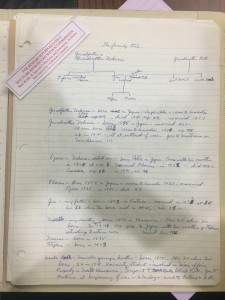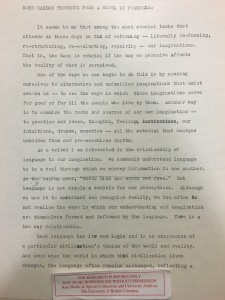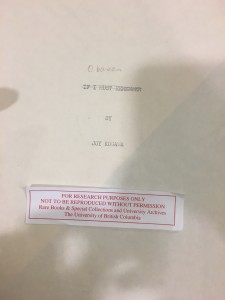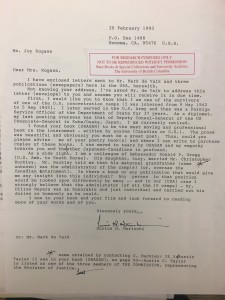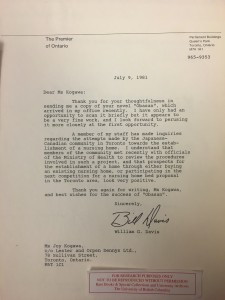Hi There,
Another two weeks have gone by and its finally time for me to share my ideas about what we are learning about in our CAP Global Citizens stream. This week however, instead of choosing a topic of my own, I will be discussing a recent ASTU ‘field trip’ we went on to the Rare Books and Special Collections (RBSC) at the Irving K. Barber Learning Centre.
The trip to RBSC was very eye-opening. Throughout my life I’ve been exposed to secondary sources, and ‘primary’ sources which were often altered or photocopied. I’ve never really had the opportunity to interact with an original artifact and the field trip gave me that missing opportunity!
It was very interesting learning about archives – documents created or received by a person or organization, and how they are organized by their creator, not the subject they belong to. The Principle of Order was necessary to maintain ‘unique and natural’ archival materials and it was interested to learn about how artifacts were further organized.
In our trip to RBSC, we focused on the fond (collection) of Joy Kogawa, author of Obasan, the literary text we are analyzing in ASTU. I was immediately astonished as to just how many files they were that pertained to the life of Kogawa. There were files for topics of all sorts varying from drafts of Obasan, letters of proposals to publishers, letters of rejection, fan mail, letters from politicians and so much more!
The first type of artifacts I was curious to look at was Kogawa’s drafts of Obasan. I was surprised to find a folder dedicated to just to planning of Obasan and brainstorming of Kogawa’s ideas on paper. In this folder I was able to access various artifacts such as the planning of the family tree of Naomi, the narrator of Obasan:
What particularly interested me in looking at the family tree planning was the historical detail versus the detail of the character’s traits itself. I was expecting to see details on the traits and roles of the characters in conveying her story, however the image illuminates Kogawa’s extensive research in portraying her story with historical context. Kogawa obviously didn’t live during the period the book had taken place in but her research into the dates and ages of the characters helped her convey her story with so much more authority.
Additionally, another artifact that I consulted was a brainstorming sheet titled “SOME RANDOM THOUGHTS FROM A NOVEL IN PROGRESS”:
This artifact showed Kogawa’s train of thought especially the argument she hopes to portray through her novel. For me, it was almost like reading a scholarly article as Kogawa informally states a knowledge deficit and what she hopes to contribute in the conversation. Kogawa states, that as a writer, she is interested in ‘relationship of language to our imagination.’ The last paragraph was the most interesting as she speaks upon the various languages of different civilizations and how they remain unchanged when the ‘civilization lives changes’. This artifact really opened my eyes and made me think of the literary aspects of the book and why Kogawa portrayed the events in the book the way she did.
Additionally, in the drafts folder, I also encountered a draft cover page which was titled “If I Must Remember.” I found it fascinating looking at the potential title and how it would still have relevance.
Finally, the last type of folder that I was able to extensively look into was letters to Kogawa from various professionals and political figures. I read a letter from Lucius H. Horiuchi, a retired U.S. diplomat, and it was amazing to read about how much Obasan impacted him.
In the letter he asks Kogawa to direct him to other sources and this made me really think of the historical context of the artifacts. Kogawa was able to so effectively portray the events Japanese Canadians had to go through and her story-telling style truly affected many individuals.
Additionally, the final artifact I consulted was a letter from the former Premier of Ontario, William ‘Bill’ G. Davis:
This letter addresses the impact of Obasan on Canadian culture. Davis mentions how there are greater efforts and a more optimistic outlook on the completion of a nursing home in a pre-dominantly Japanese-Canadian community in Toronto. This reminds me of redress, the politics of apology, which I spoke about on my blog last week.
In all, I find it amazing how a novel, which isn’t even based on ones personal recollection, holds so much authority and can so effectively convey the struggles of Japanese Canadians during the internment in World War II. The field trip to the RBSC really opened my eyes and allowed me to explore how Kogawa developed her novel and obtained authority using historical context. The RBSC is a place I would definitely return to and I would love to further explore Kogawa’s fond without time constraints.
Until Next Time…
